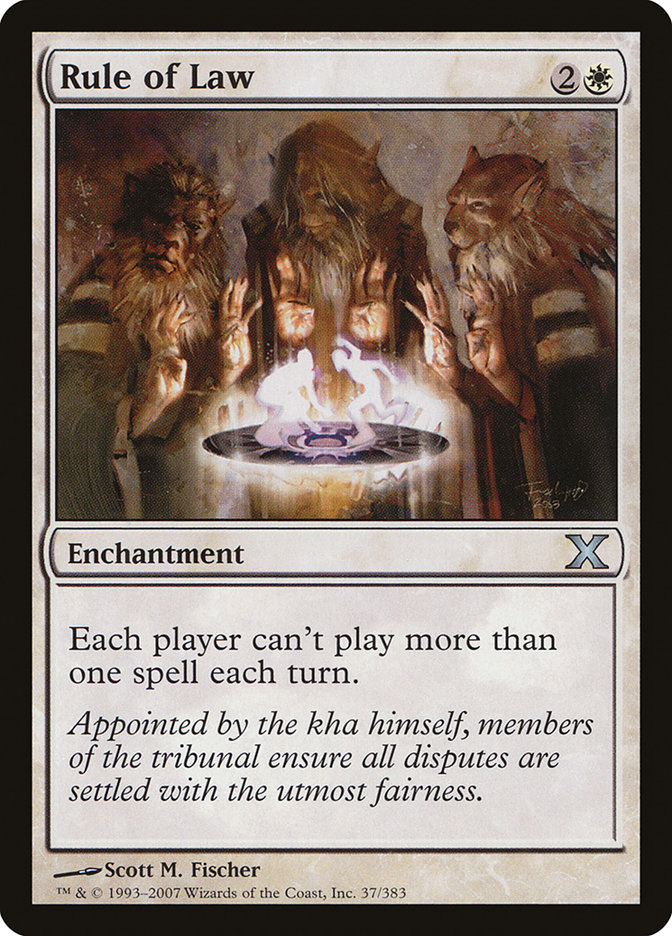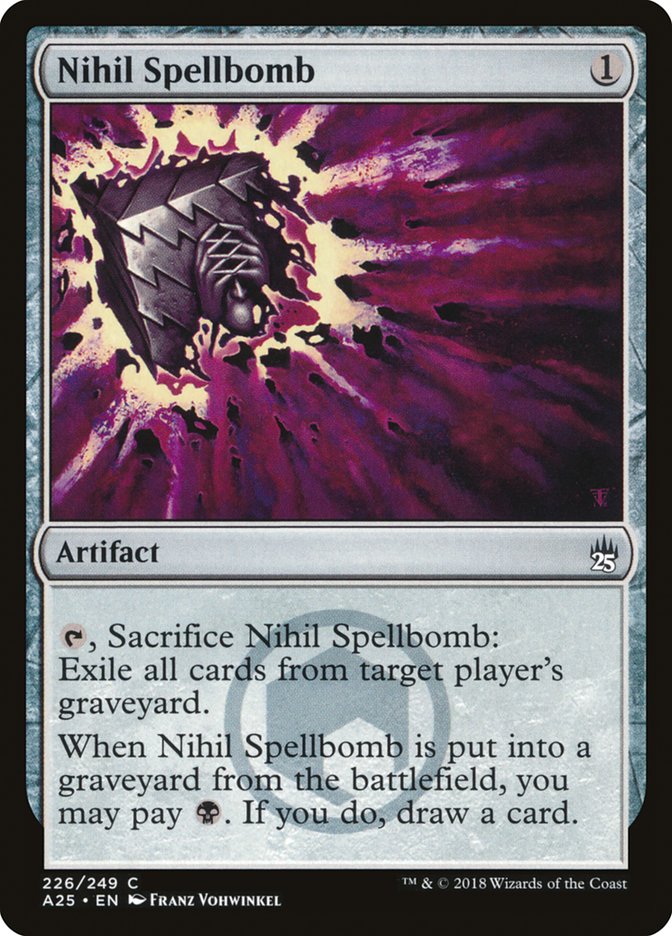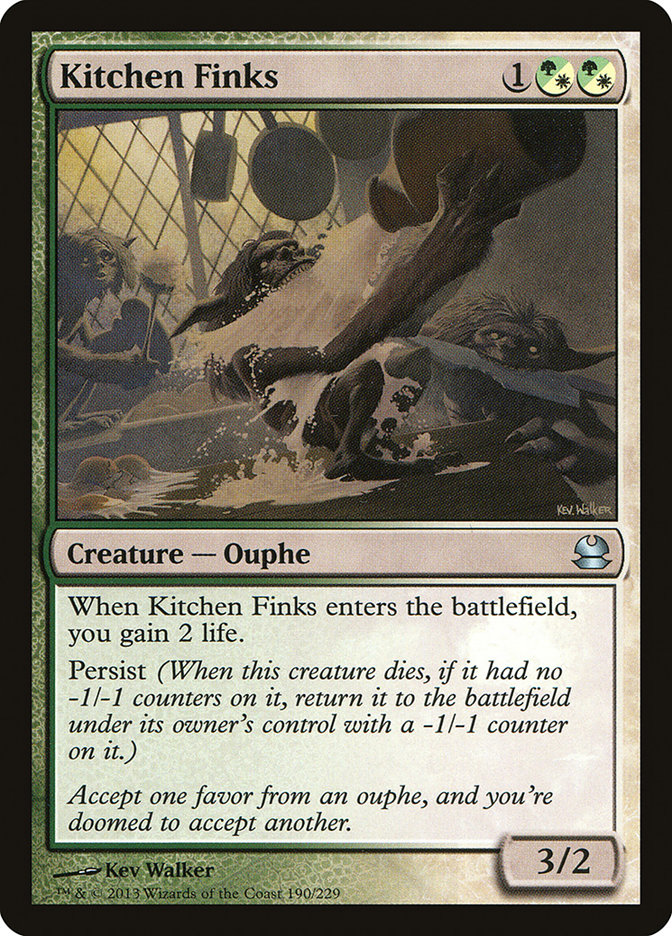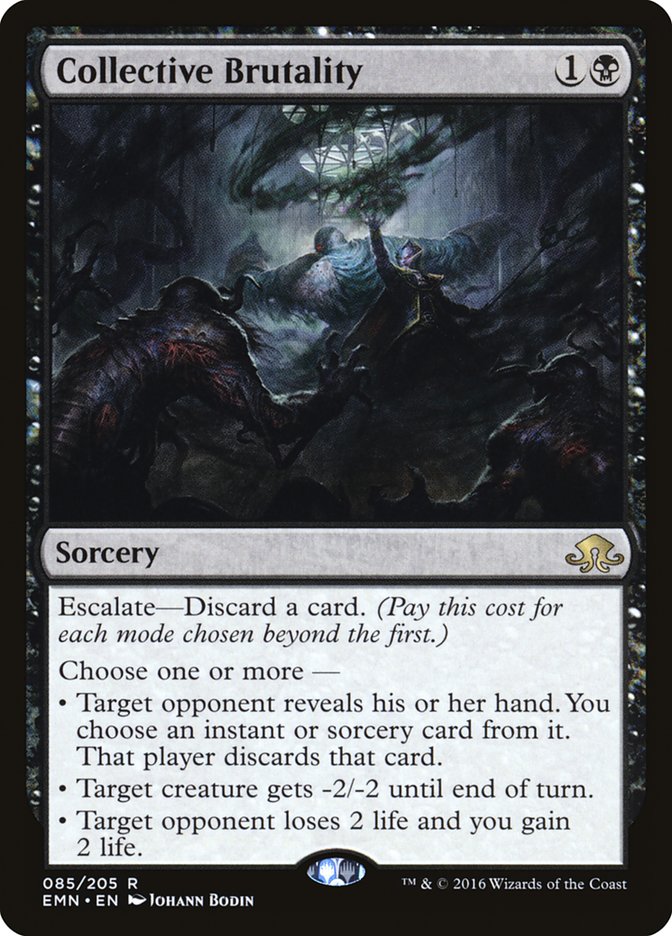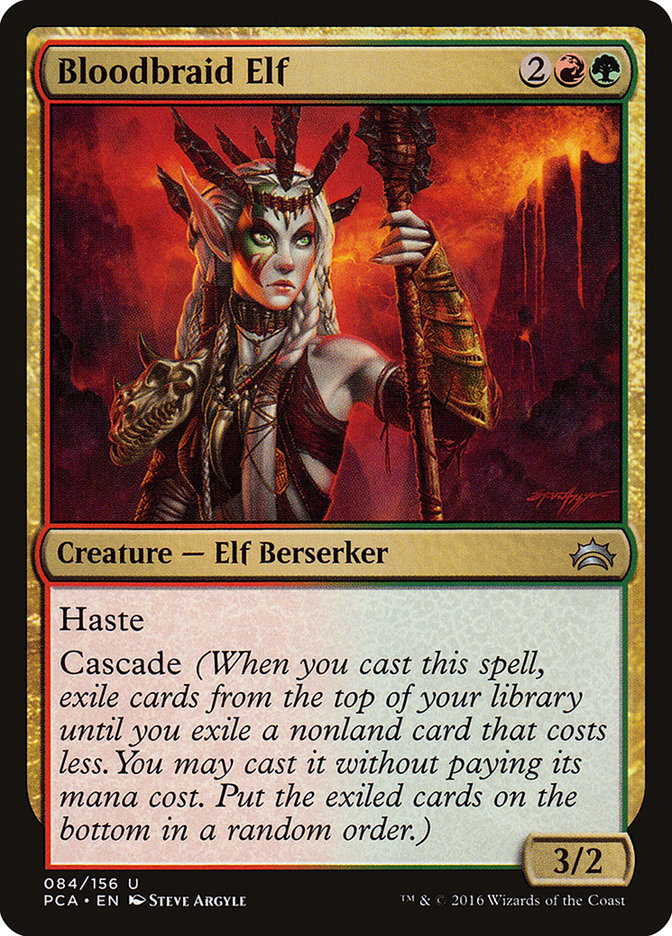There’s always a boogeyman.

Play a matchup more than once or twice and you’ll quickly identify what
boogeymen lay in store for you. Things are going fine and then look at
that: There’s a copy of The Scarab God you can’t beat. You’re feeling
pretty good about your spot, but then a Jace, the Mind Sculptor comes down
and two Brainstorms later, you start to see the writing on the wall.
Some cards are better than others.
Maybe you don’t care. You have a plan and you’re sticking to it. When your
deck’s working, you Lava Spike them to zero in short order. It’s when you
draw a few too many lands that Jace starts to look good. Doubling down on
your A-plan and trying to win before these cards become relevant is one way
to best these haymakers.
For other players, the natural response to losing over and over again to
the same card is to look for and start playing more cards that answer it.
Dreadbore your Jace. Harsh Scrutiny your Rekindling Phoenix. Rule of Law,
turn all your Bloodbraid Elves into Vulshok Berserkers.
Of course, some answers are better than others.
My very first competitive game, way back in elementary school, was chess. I
was never very good, and as a result spent a lot of time around newer
players, helping them learn the game and such. High-level chess is an
elegant game of strikes and parries where players can capitalize on small
missteps with game-ending attacks that appear out of nowhere. At the same
time, elegant is one of the least appropriate words possible to describe
beginner’s chess.
Chess games between novices tend to end in one of two ways. Some kids
become enamored with the all-in, gimmicky strategies of chess and
relentlessly go for the Scholar’s Mate (a simple, four-move checkmate) or a
variation thereof every game. When that doesn’t work, their games devolve
into all-out brawls where every opposing piece must be captured before an
attack on the king can commence.
And that’s kind of the way of things in novice level chess. Games end
quickly due to memorized attacks or they end only after one player has had
every last one of their hopes and dreams crushed over the chess board. The
clever mid-game attacks that can end the game with pieces still on the
board are beyond the skill level of players at this level. Unable to trap
the king while its army survives, beginners focus on capturing the biggest
enemy threats. First they try and capture the queen, then they go after the
rooks. Bishops and knights are the next to fall, after which pawns will get
picked off as the king is forced to run. One player has pieces, the other
doesn’t. The winner is clear.
Magic players often exhibit the same tendencies, except in our game, it’s
not just the beginners. Often, it’s correct to select and execute a
non-interactive strategy, the parallel to the memorized early attacks of
the novice chess player. Every format has decks that fit this mold, and
choosing one of them is something players of all levels should consider for
every tournament. Case in point:
Creatures (8)
Lands (18)
Spells (34)

No, the troublesome part of this analogy is when Magic players think it
necessary to have an answer to everything. It’s an understandable belief.
You can only lose to Glorybringer so many times before you start to think
that maybe some of your cards should be able to get said Glorybringer off
the table. When playing a deck that doesn’t plan to win before Glorybringer
comes down and that is trying to establish the kind of battlefield
dominance that Glorybringer is so good at disrupting, it’s only natural to
think you need to be playing some anti-Glorybringer technology. But do you?
A few weeks ago, I wrote an
article
about how to beat The Scarab God in Standard. Yes, the first point
discussed was being sure to play cards that could answer it. However, that
wasn’t the only point discussed. Answers are great and all, but
they aren’t the only way to beat a card. And in my experience, winning a
game with your opponent’s best card still on the battlefield is one of the
most satisfying ways to win there is.
Finding ways to beat cards without playing specific answers is especially
important in Modern because the format is so large. In Standard, if the
card The Scarab God is causing you fits, you can afford to make some pretty
drastic changes to your list in order to better handle it, because you know
a full third of your opponents are likely to cast it against you. In
Modern, even if every U/x Control player in the room has against has
elected to play the full four copies of Search for Azcanta, you could still
very easily win the whole tournament without ever staring it down. That’s
just how Modern is.
The Three Tiers of Adaptation
So, you want to go to a Modern tournament. You’ve picked out a deck and
you’ve been practicing with it as much as your schedule will allow. Your
only problem in the world right now is that you can’t seem to win a single
game after your opponent puts spell X on the stack. You’ve decided that
you’re not comfortable losing to X at such a high rate, as you believe you
will see a lot of it. Where should you begin in trying to increase your
winrate against this card?
The operative maxim here is this:
The best adaptation among those that achieve your goal isn’t the
“winningest” one, but the smallest one.
The idea here is that when you decide to make yourself better against card
X, it’s of critical importance not to tunnel vision in on this card. Sure,
you can probably make yourself 90%+ to beat that card, but doing so will
often leave your decklist both completely unrecognizable and just worse
against the rest of Modern’s wide field. Instead, you want make the
smallest possible change that also raises your chances in the spot enough
to make you happy. Working to minimize the severity of the change rather
than maximize your win rate ensures that you don’t chop down the whole
forest in order to save a single tree.
My method to accomplish this is to start with the smallest possible changes
and work my way up. The first category of changes I consider are playstyle
changes. That is, I think about how I can play my cards differently in
order to have a better result against card X. I think about everything from
my overall game plan in the matchup to optimal sequencing to the relative
importance of card advantage and mana efficiency in my quest to beat card X
by merely playing the same cards I’ve been playing all along, but now
playing them a little differently.
Also included in this tier is finding uses for sideboard cards that you
hadn’t previously considered. Maybe the graveyard hate you always pack is
historically terrible in this matchup and you’ve never considered bringing
it in before, but now that they are packing card X, your graveyard hate
actually has an application. Modern’s size has selected for flexible
sideboard cards throughout its entire history, so it’s common for the
sideboard cards you’re already playing to have new and unexpected uses as
the metagame changes.
Next, I start to consider soft answers. Generally, these are cards that
don’t directly answer the card in question, but do enhance an aspect of my
game plan that is particularly good against card X. Ideas for soft answers
generally come to me as an extension of my work in adapting my playstyle to
beat a certain card. Often a certain play pattern is nearly good enough and
the cards you need to have access to in order to make it actually good
enough are apparent.
Alternatively, soft answers can be cards that are in the same class as
cards that you do typically play, but that have historically proven to be
weaker and thus, have fallen by the wayside. However, with the rise of card
X, these soft answers have new utility that the previously determined
‘better’ cards do not. Often you see these patterns occur with the removal
suite in decks, as previously unpopular cards see increased play to handle
the new threats in the metagame. Because the class of card, removal, is
still the same, these changes do not register as particularly drastic.
Only after I’ve exhausted every possibility I can think of in the previous
two tiers do I start to look into hard answers. These are cards that have a
huge interactional advantage with card X, that answer it cleanly and leave
you fairly ahead on the exchange, but that are very narrow and won’t be of
much use to you in other matchups and spots. Often you will be able to
think of some other uses for them, but don’t kid yourself: if it wasn’t for
card X, you wouldn’t dream of putting these cards in your deck, and the
other spots you’ve found for them are marginal at best.
There’s times when hard answers are your only options, but they’re few and
far between. They are the most constricting option available to you, and
the option most likely to inflict damage to your win rate in other
matchups. In spite of this, they are still the most popular kind of
solution with Magic players at large, likely because they do what you want
them to very obviously and spring to mind easily. I’m not going to talk
about hard answers any more today despite their utility every now and then,
because my goal for this piece is to work on ways to beat cards without
playing the clean answers. Just remember that if nothing else you do works,
feel free to play that Destroy Target Permanent effect of your dreams.
Jace, the Mind Sculptor
Time for some applications, and what better adaptation examples to draw on
than the two biggest shake-ups to the Modern format in the last year?
We’ll start with Jace, the Mind Sculptor. Now, Jace has not proven to be
nearly as formidable as we feared when news of his unbanning hit, but it’s
often fear that causes adaptation, not reality. I know many players who
were going as far as Pithing Needle in their quest to not lose to Jace, a
hard answer if I ever saw one. What did my process look like, you ask?
The first thing to ask is what situations is Jace good against you in? With
Jace, the answer is whenever he gets to sit on the battlefield and use his
zero ability multiple turns in a row. When Jace dies immediately, he’s just
a very expensive card draw spell. When he gets an extra turn, he’s a very
cheap card draw spell. When he gets two extra turns, he’s ethical cheating.
So, how do we stop Jace from getting those extra turns? Simple, we don’t
concede the battlefield to our opponent. We need to attack Jace down the
second he enters the fray. We need to punish our opponent for choosing to
spend four mana at sorcery speed. We need to make our opponent unable to
have mana to both defend Jace and cast Jace.
The very first thing I tried in my testing was to give less respect to
Supreme Verdict. Previously against U/x control matchups, I tried very hard
to present a single threat at a time and only let their wraths be one for
ones. Because of Jace’s bounce ability, I decided to up my ideal
battlefield state to two creatures in these matchups.
And you know what? For the most part, that was all I had to do. There’s a
reason Jace isn’t taking over Modern in the way everyone feared.
The truth is that the optimal Jace play patterns are easy to grok. You want
to be able to attack Jace down right away, which means maintaining a
battlefield of two or more creatures. Jace’s lack of success isn’t because
these play patterns are easy to understand though, it’s because they are
easy to achieve. All of the decks in Modern that Jace is theoretically good
against are good at creating imposing battlefields, making it difficult for
him to find success.
The more interesting parts of the Jace adaptations are the various soft
answers people started playing. Dreadbore, for instance, has started seeing
much more play since Jace got unbanned. It’s that exact scenario I
discussed previously: a slightly worse removal option that mostly does the
same thing as Terminate in a slightly worse way, but is much better against
exactly Jace, the Mind Sculptor.
Even the spike in play of Lightning Bolt owes something to people adapting
to Jace. There’s other reasons to be playing Lightning Bolt right now,
sure, but being able to kill a greedy Jace is definitely on the minds of
pilots choosing to register Lightning Bolt.
These things are important to note and keep an eye on, as they are things
we will want to pull out of our bag of tricks later if Jace becomes better
positioned in the format. Right now I can’t recommend playing Dreadbore
over Terminate, but two months from now? Who knows.
Bloodbraid Elf
Jace adaptations are on hold right now, as the metagame overcorrected to a
perceived threat that never materialized. If someone finds a Jace shell
that works, we’ll see more Jace adaptations come out of the woodwork. In
the meantime, we’ve only just begun adapting to this girl:
Again, the first thing we should ask ourselves is what situations does
Bloodbraid Elf beat us in, and how can we avoid those situations?
Bloodbraid Elf is good when she’s giving her controller two cards for the
price of one. You can make Bloodbraid Elf bad by either making the 3/2
haste body not worth a card, or by minimizing the chances that the cascade
hits a real spell.
Think of it from the perspective of the Bloodbraid Elf player. They want to
cast Bloodbraid Elf when anything they hit is going to be good. Ideally
they’re at parity or very close to it and casting pretty much any spell in
their entire deck is going to pull them ahead. Now flip the script.
You want them to cast Bloodbraid Elf when they need a very specific
cascade. Maybe you prioritize aggressively trading off creatures, so that
the battlefield is empty when they go to cast Bloodbraid Elf and any
removal spell they hit is worthless. Maybe you up your frequency of going
all-in on a single threat, effectively forcing their Bloodbraid Elves to
cascade into removal.
Or maybe you forget about the bonus card and seek to assemble a battlefield
of creatures that can easily rumble with a Bloodbraid Elf, turning the
front half of the card into a non-entity.
The problem with Bloodbraid Elf is that, unlike Jace, these play situations
are difficult for many decks to achieve. Simply varying how you play your
cards is unlikely to greatly enhance the probability that you reach these
beneficial game states. It’s time to look at some soft answers. But first,
look at this Grand Prix Phoenix Top 8 list.
Creatures (37)
- 4 Meddling Mage
- 1 Dark Confidant
- 4 Noble Hierarch
- 1 Mirran Crusader
- 3 Phantasmal Image
- 4 Champion of the Parish
- 3 Thalia, Guardian of Thraben
- 4 Mantis Rider
- 4 Reflector Mage
- 4 Thalia's Lieutenant
- 4 Kitesail Freebooter
- 1 Dire Fleet Daredevil
Lands (19)
Spells (4)

How did this Five-Color Humans deck adapt to handle Bloodbraid Elf?
The relevant decisions here are the copy of Dark Confidant, the copy of
Mirran Crusader, and the decision to trim a copy of Thalia, Guardian of
Thraben. Let’s tackle them in order.
Dark Confidant is another must-answer threat in a deck of must-answer
threats. The Five-Color Humans deck is excellent at assembling battlefields
of huge must-kill creatures like Champion of the Parish alongside tricky
disruptive creatures like Meddling Mage that are also must kill. Dark
Confidant enhances this angle of attack, adding another creature that the
Jund deck cannot let live, severely restricting what Bloodbraid Elf hits
are good. An excellent soft answer.
The copy of Mirran Crusader is bordering on a hard answer, but I’ll allow
it. It works against Bloodbraid Elf on nearly every axis. Most of the
creatures in the Jund deck don’t block it and most of the removal doesn’t
kill it; what is Bloodbraid Elf even supposed to hit? At the same time,
Bloodbraid doesn’t tangle with the Crusader herself either, making the 3/2
body significantly less relevant.
Cutting the Thalia is probably my favorite anti-Bloodbraid decision here.
At first brush, it seems like a bad move against Bloodbraid Elves.
After all, if they cascade into a non-creature spell with Thalia on the
battlefield, they have to pay a mana for it. If they Bloodbraided on turn
4, they won’t be able to cast it at all! That’s good, right?
Trick question. That is good, but your Bloodbraid-wielding opponent will
simply not cast their Elf without a mana to spare. Your trick won’t work
against good players. At the same time, Bloodbraid Elf has caused Jund
players to both play more lands and prioritize making their land drops
higher. This means that Thalia is less effective than she used to be
against the archetype.
This Five-Color Humans list is only a few cards off the stock lists of last
month, but those few changes let it achieve favorable positions against
Bloodbraid Elf much more often, while not affecting its capabilities in
other matchups to a huge extent. A great example of the power of soft
answers.
Maybe this all sounds like too much work. It’s certainly easier to just
throw some hard trump cards into your sideboard, hope to draw them when you
need them and call it a day. Here’s the real magic at work in this process
though: by exploring all these angles, no matter what tier of solution you
end up employing, you gain significant edges even when you don’t find your
answers.
Six weeks from now, a new Jace deck takes off in popularity and is
dominating tournaments. You keep losing to its Jaces, and you decide you
want that to stop. You explore every way to play your cards you can think
of, and nothing you try gets you comfortable with your win rate. You start
mixing some planeswalker removal into your interactive slots, and that
seems to do the trick.
It’s the day of your tournament, and you’re ready to go. You play against
that Jace deck you’ve been fearing right off the bat, but you know you’re
ready. It comes down to game 3, and they slam that turn 4 Jace. You look
down at your hand and don’t see that Dreadbore you need. Guess you lose,
right?
Wrong! Because you spent all that time testing variations on play patterns
that could help, you know what to do without that Dreadbore. Sure, your win
rate in these cases wasn’t good enough for you to not play those
Dreadbores, but it wasn’t zero. You know what to do when you don’t
have access to Dreadbore, which you only learned by not skipping directly
to soft answers when trying to beat these Jaces.
Put in the work and you’ll be rewarded.


